Craft beer is defined as being traditionally produced by small breweries with less than 6 million barrels a year and independently-owned. In the last decade, the number of brewery establishments has sextupled (grown by a factor of six times). In that same time frame, the number of brewery workers has more than doubled. Craft beer production now accounts for 12.7% of the beer market volume in the U.S. Last year (2017), a record breaking $26 billion dollars of craft beer was sold in the U.S. – accounting for nearly a quarter of the $111.4 billion-dollar beer industry sales!
What we are witnessing (and enjoying) is a craft beer revolution.
Quality in every aspect of the operation is essential to the survival and growth of a craft brewery. It’s not just knowing how much lavender to season your next pilsner with, how long your Indian Pale Ale (IPA) needs to ferment, or how many hops are needed to give your chocolate stout its unique smooth taste: it is planning for high-quality operations, distribution logistics, marketing, internal communication, management, and a lot of hard work that help make a brewery thrive.
In this guide to opening a brewery, we’ll give you an overview of what you need to get started, including essential nanobrewery equipment, legal considerations for permitting and zoning, and a suggestions for designing a brewery using unique and green building solutions.
THE DIFFERENCE BETWEEN A NANOBREWERY AND A MICROBREWERY
There are five categories of breweries: macrobreweries, microbreweries, nanobreweries, brewpubs, and home breweries. Technically, nanobreweries and brewpubs fall under the microbrewery category. For the sake of this guide, and to better differentiate the two, we have separated them.
- Macrobrewery: produces and distributes over 6 million barrels of beer per year.
- Microbrewery: produces and distributes less than 6 million barrels of beer per year.
- Nanobrewery: produces and distributes less than 200 gallons of beer per year.
- Brewpub: brews its own beer and only sells on premises.
- Home brewery: produces non-distributed homebrews.
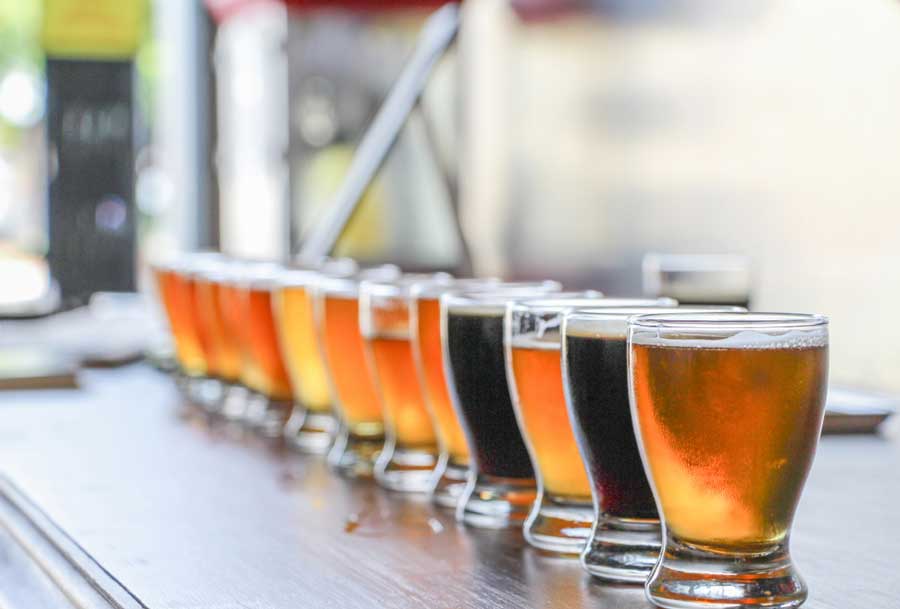
STARTING A NANOBREWERY
Starting your own nanobrewery is work, so don’t jump into it on a whim thinking because you’re producing less than 200 gallons of beer per year, it will be easy or a ‘get-rich-quick scheme’. A love and affinity to great tasting beer is a good place to start, but to be successful, you need to approach it the same as you would any other type of business, because that’s exactly what it is.
Starting a new brewery (of any scale) is a capital-intensive choice that needs to be considered carefully. A new 31-gallon single barrel can cost as much as $100,000. While you can certainly buy used brewery equipment to save money, opting for home-made solutions or buying the cheapest equipment will likely results in on-going and costly maintenance, not to mention be difficult to expand when your brewery grows and needs to increase production capability.
BREWING PERMITS, LICENSES AND INSURANCE FOR BREWERIES
Nanobreweries typically do not generate enough revenue to make wide-scale distribution profitable. You’ll need to sell the majority of your beer for on-premise consumption or to nearby and local tap rooms. Whether you are legally able to sell beer from your brewery’s location depends on your local and state laws. We recommend seeking the legal counsel of a firm or experienced lawyer in your area to help navigate the licensing and permitting of your brewery.
That having been said, before you fire up the boilers, you’ll need to apply for a federal brewing permit. This is a free application filed with the Alcohol and Tobacco Tax and Trade Bureau (also known as the Tax and Trade Bureau, abbreviated TTB). The TTB application usually takes several months to process. Prior to issuing your brewing permit, the TTB will want you to get a brewer’s bond and verify all your brewery equipment is installed and operational.
A state liquor license, in addition to local licensing, is required if you want to capitalize with strong on-premise and tap room sales by serving beer at your brewery.
If you plan to sell merchandise like hats, shirts, hoodies, mugs, or one-of-a-kind beer steins embellished with your brewery logo, you guessed it – you’ll need a license for that too!
In addition to becoming a tenacious bookkeeper, keeping your permits active and in good standing, as well as successfully running your own brewery business, you should also consider insurance. If you are seeking a business loan or wish to secure finances from a bank to help with the startup costs, you will likely be required to get and show proof of having property, casualty, and liability insurance.
Especially in the early days, one legal misstep can crush all of your beer making efforts, leaving only debt in place of your brewing ambition. Not to sound like a broken record – for this reason, we recommend you seek the expert advice of legal counsel in your area for ensuring you have the proper permits in place before starting a brewery.
LEARN YOUR CRAFT (BEER)
Know how to brew good beer. Gain an in-depth understanding of the brewing process. Just ‘winging it’ will not get the job done. Having friends who say they would buy your beer is a start, but not the foundation to building a successful brewery. While experimentation is key to discovering new tastes, there are time honored principles and methodologies for producing quality beer. Brewing is a science, a craft, and some would even describe brewing as a form of art. Just as a sommelier is expected to have an expert level understanding of wine production, if you are passionate about beer and opening a brewery, you need to devote the time, gain an understanding of how to make beer, and build a similar foundation of knowledge.
If this your first foray into brewing, there are many online resources and books about brewing beer or opening a brewery. We recommend you start there. Another avenue to learning how to make beer and become a professional brewer would be to attend an accredited brewing school. All About Beer Magazine produced a list of brewing schools and beer industry education programs by state.
If you already have a good understanding of the brewing process and making beer, seek out the experienced advice from well-known or successful brewmasters (‘brewmeisters’ in German) for critique. Ask them to be critical of your work. Brutal honesty is hard to come by and can be hard to hear. Critical reviews and critiques from a brew master should be met with humility, respect, and regarded as a learning opportunity so you (and your beer making skills) can improve.
Get your beer recipes down to a science! The phrase ‘brew like a monk’ is most commonly used to describe the processes for producing monastic abbey and Trappist style beers with centuries of history – symbolizing the highest quality in brewing. The phrase is also jargon used to describe head brewers, professional brewers, as well as amateur brewers that consistently produce a great quality beer. These are individuals who know something about brewing and can tell you when calcium carbonate is needed to remove an acrid and bitter aftertaste.
LEARNING FROM YOUR BEER MAKING MISTAKES
Before opening a brewery, know mistakes are going to happen. Learn to deal with them. Look at them as another learning and growing opportunity. Even large breweries (macrobreweries) run into issues and have to quickly overcome obstacles. Knowing how to address and work around them is essential to the business, brand, and maintaining the ability to produce a high-quality beer. For every question that comes up, study or seek the advice of an experienced brewer to learn the answer. Very much like the wine industry, professionals in the beer industry are eager to help each other and will tell you about their good and bad experiences.
When action is needed to correct a mistake – formulate a plan and keep moving forward. Understand and minimize the risks involved, so as not to over-extend or carelessly create a business model that isn’t sustainable or profitable.
START SMALL AND EXPAND YOUR BREWERY
Start small. Word of mouth by those who like your beer will help establish a small community of followers. Branch out and expand your customers by attending farmer’s markets, local, county, or state fairs, arts and craft fairs, sporting events, concerts, and performances.
When attending an outdoor or promotional event, be sure to stand out from the crowd of white pop-up canopies by setting up a custom-made outdoor canopy to attract the attention of potential new customers. Sponsor beer related events in and around your community to get your brewery’s name out there!
Get on social media and let customers know of upcoming releases, seasonal beers, or events! Enter beer contests. If are you are doing something right, your beer should be consistently scoring well at BJCP-sanctioned events.
A bit of (sober) planning, patience, due diligence, and a great deal of tenacity will go far to creating a popular neighborhood watering hole.
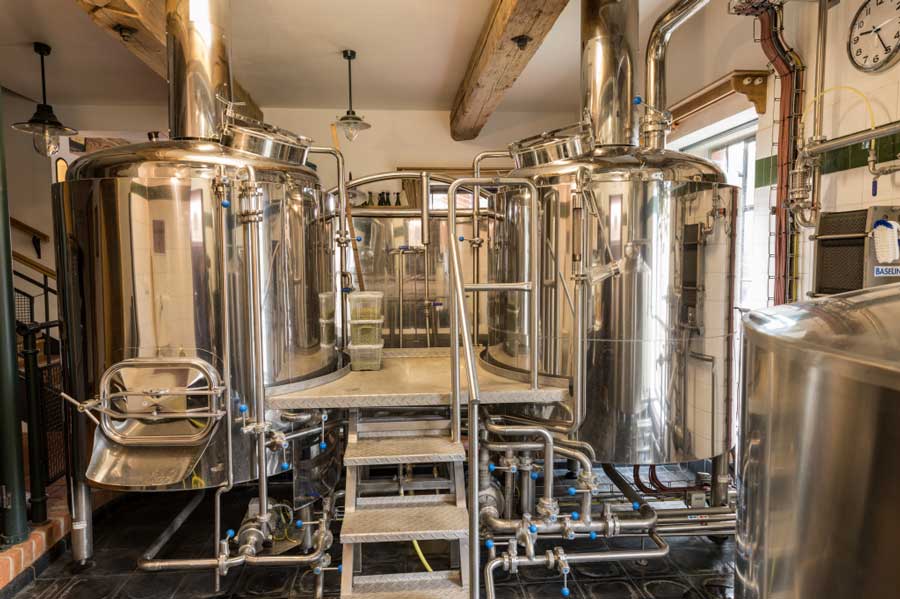
ESSENTIAL EQUIPMENT FOR OPENING AND OPERATING A BREWERY
Whether you are brewing your favorite light bodied ale, a crisp lager, or seasonal beer, having the right equipment is essential to opening and operating a brewery. There are many choices when it comes to selecting manufacturers that produce individual pieces of equipment or complete turn-key systems for breweries. We recommend contacting local or nearby companies and discussing your brewery size to better determine the necessary equipment to start or expand your brewery. Local companies will offer a more personalized experience, and should you need support, they are just down the road to get you back up and running quickly!
Below is a list of commonly used equipment for brewery operations:
Bottling equipment
With fermentation and/or aging complete, you’re ready to bottle your beer.
All of the following equipment is necessary and must be sanitized before use:
- Bottling bucket
- Beer bottles
- Bottle caps
- Priming sugar
- Auto-siphon
At this point, your beer will be sitting on top of a layer of trub. Trub is sediment made up of dead yeast, hop pieces, malt, and unfermentable brewing products. Disturbing the trub while racking will ruin the post-primary fermentation and cause off flavors. “Racking” is the process of separating the beer from the trub, often by moving it from the first fermenter into the second before finally bottling.
There is much more detail needed than the equipment and procedures described above that makes brewing possible, and at scale. Additional equipment used by brewmasters to prepare and make beer include:
- Canning lines
- Beer filtering equipment
- Beer labeling machines
- Kegs
- Brewery conveyors
- Cleaning equipment
- Wastewater treatment systems
- Custom beer tap handles
Piping, tubing and brew pumps
The three main types of brewing pumps include peristaltic, diaphragm, and centrifugal pumps.
- Peristaltic pumps push liquid through a flexible tube by mechanically compressing the tubing. This works the same way as squeezing toothpaste out of a tube, but in a continuous circuit.
- Diaphragm pumps move water into and out of a mechanical diaphragm by increasing and reducing the pressure in the pump housing.
- Centrifugal pumps are the most common brewing pumps. Centrifugal pumps use a shaft-driven impeller that spins inside a casing. The pump sucks liquid into the inlet of the casing and throws it to the casing’s outlet before forcing it through the discharge port. The force of being thrown to the outside of the casing quickly propels the liquid.
Beer storage and fermentation tanks
The shape of the fermentation tank that you use depends on the type of beer you are brewing. The most commonly used fermentation tanks are covered cylindrical-conical tanks, abbreviated CCT or CCF. The ratio of height to diameter changes the hydrostatic pressure, which in turn changes the properties of the beer fermenting inside. Some beers do better with the higher hydrostatic pressure found in 4-1 tower tanks, and others do well in extra wide 1-1 tanks.
Just putting a carboy in a back room and waiting for the fermentation to finish isn’t the way to properly ferment your craft beer. You need to maintain the specific temperature required for your type of beer using a cold room or a temperature-controlled fermentation chamber. Lagers, for example, are very specific and require the temperature be kept at a strict 34°F.
If you are not using a temperature-controlled fermentation chamber, then the room temperature must be kept at a steady 34°F. This is a problem for breweries that have limited space and are making multiple types of beer, as the required temperature for fermenting one beer may ruin a batch of another type of beer. So, you either need to have each fermentation tank be temperature-controlled, or you need separate rooms — each kept at the appropriate temperature according to what is fermenting inside of them.
Wooden barrels are making a comeback and are used for both storing and aging beer. Aging can mellow and blend the flavors of a beer. This is popular with barley wines and old ales, where oxidation that takes place compliments the already existing flavors in the brew. Storing beer and aging in wood barrels is not every beer. For more hoppy beers like IPAs, this often dulls the flavors and removes the bite.
Whether you use barrels to age your beer or store your beer in stainless steel tanks entirely depends upon your preference, the type of beer you are brewing, and whether you want to mellow it. Aging beer in stainless steel tanks does not improve the character of the brew. And aging beer doesn’t typically make a beer better like wine.
Once you have determined how you will store your beer, it needs to be kept cold. Craft Beer USA explains that “beer stored at 100°F for one week tastes as old as beer stored at 70°F for two months, or as old as beer stored at 40°F for one year.”
Temperature is responsible for nearly all draft beer problems. Unpasteurized ale and lager type beers, for example, must be kept between 36˚F and 38°F up until being served. CO2 breaks out of the beer just half a degree above 38°F, and bacteria begins to grow at 50°F, spoiling the flavor. Different types of beers require different temperatures, and those temperatures must be strictly maintained.
Chilling and cooling systems
The wort must be cooled quickly. Temperatures above 140°F inhibit bacteria and wild yeasts, but you must be careful once you drop below that threshold. The wort becomes very susceptible to oxidation damage if it cools too slowly; and dimethyl sulfide may form, causing off-flavors in the finished beer. To prevent this, you must cool the wort below 80°F before contamination or oxidation can occur.
While you can use an ice bath to cool the wort, copper wort chillers are much more consistent. Copper wort chillers consist of copper tubing used as a heat exchanger to cool the wort. There are two types of wort chillers, immersion and counter-flow:
- Immersion wort chillers work by (as the name suggests) immersing the chiller in the wort. Water inside of the chiller carries the heat away.
- A counterflow chiller, or CFC, works by draining the hot wort from the pot through copper tubing while cold water flows outside of the chiller.
Once the wort is chilled, you need the right set of pumps and pipes to move the wort into the fermentation tanks.
Brewing kettles and boilers
Whether you are working with five, ten, fifteen, or more gallons at a time, this is where you begin by boiling your wort. The most important criteria for you to consider when buying your brew kettle is the volume it holds. You need head space to prevent overboiling when working with larger batches.
Electric heating elements bring the wort inside of the brew kettle to a boil. The size of your heating element matters. It needs to be large enough to quickly bring the wort to and maintain a rolling boil. The size of the element you use depends upon the power source it is drawing from, since different wattages will heat the brew kettle at different rates. Luckily, there are a number of online calculators available to help determine how much wattage you need according to the volume you are brewing and the amount of thermal loss your boiling vessel permits.
Simple online calculators:
Temperature Rise for Power
Power Required for Temperature Change
CHOOSING THE BEST BREWERY LOCATION
Brewery owners and brewmasters will say the location and size of your building are the two most important factors to consider when constructing, purchasing, or renting a space for brewing craft beer.
You need a location and a building to establish and operate your brewery. It is highly unlikely that you can legally operate a craft brewery out of your home. Warehouse space in major metropolitans will come at a premium cost and with lots of competition. On the other end of the spectrum, you don’t want to be so far out in the “sticks” that nobody, other than a small group of friends, know you are there. Is there a ‘Goldilocks Zone’ for breweries?
The short answer is yes. Though the craft beer revolution has pushed the boundaries where breweries have traditionally been located, allowing them to establish residency by using creative strategies for designing and building facilities for gaining greater attention, even in small rural towns. Craft breweries have found a way to quite literally ‘tap’ into the growing beer tourism industry. The term “beercationing” is used to describe entire vacation trips planned around visiting craft brewery hotspots. Beercations have gained such popularity, they have created a new sales channel for selling beer. A recent survey found the average craft beer drinker will visit 3.5 breweries near their home and visit 2.5 breweries within a two-hours’ driving distance.
Breweries with tap rooms featuring modern pendant lights, bars made of reclaimed wood – reminiscent of swanky and trendy bars in major cities – are sprouting and flourishing just about anywhere were zoning by-laws allow. Some craft breweries have become so popular, they describe themselves as ‘destination breweries’ capitalizing on the artisan economy, offering guests hotel and spa accommodations, attracting visitors from across the United States and world!
Now that breweries have the ability to sell directly to consumers, special thought should be given to selecting a brewery location including: access to highways and local roads, nearby attractions, target demographic, distribution strategy, and budget.
ZONING FOR BREWERIES
Traditionally, zoning by-laws have relegated breweries to the same locations zoned for manufacturing. These industrial districts are usually not favorable for creating community gathering places, restaurants, bars, or tourist destinations. Many local governments have taken notice of the growing popularities of craft breweries and changed their zoning requirements to create a more welcoming business climate.
Because breweries of today cater to a wide range of applications including: restaurants, bars, retail, brewery, manufacturing, warehousing, and distribution – zoning by-laws can mean a certain activity is allowed in one neighborhood and not the next. There are many other factors that could affect the approval of a potential brewery site. These can include parking availability, impacts to local traffic, dimensional requirements and requirements for proper wastewater discharge.
We recommend you work with your local planning department, a local permitting specialist, or hire a law firm that is familiar with the zoning by-laws to determine the best possible sites early in the planning stages of starting a brewery.
PLAN FOR EXPANSION WHEN DESIGNING A BREWERY
When designing your brewery’s floor plan, special attention needs to be given to the layout for creating an optimized space that allows for supply and material storage, access into the brewery, efficiency and flow of the materials and equipment used in the brewing process, beer storage, restaurant, bar, and retail space!
A recent survey of more than 60 professional brewers highlighted the most commonly made mistake – not accurately estimating the brewing space needed for initial beer production and space for future growth and expansion. The advice offered is to take your brewery’s initial size and capacity estimates, and then double or triple it!
Understandably, the solution of doubling or tripling your brewery’s space for future growth may not be financially feasible at the time of startup. High-quality WeatherPort® tensioned fabric structures from Alaska Structures® offer an alternative solution for brewers.
Engineered fabric structures allow brewers to quickly expand their existing infrastructure, or quickly establish an environmentally friendly building solution for brewery operations in a fraction of the time compared to the construction of brick-and-mortar, concrete or tilt-slab construction, wood or metal buildings. WeatherPort offers many different models of fabric buildings, in a wide range of sizes (8’ wide to 150’ wide, custom designed to any length) to create spaces big and small for all aspects of beer production including:
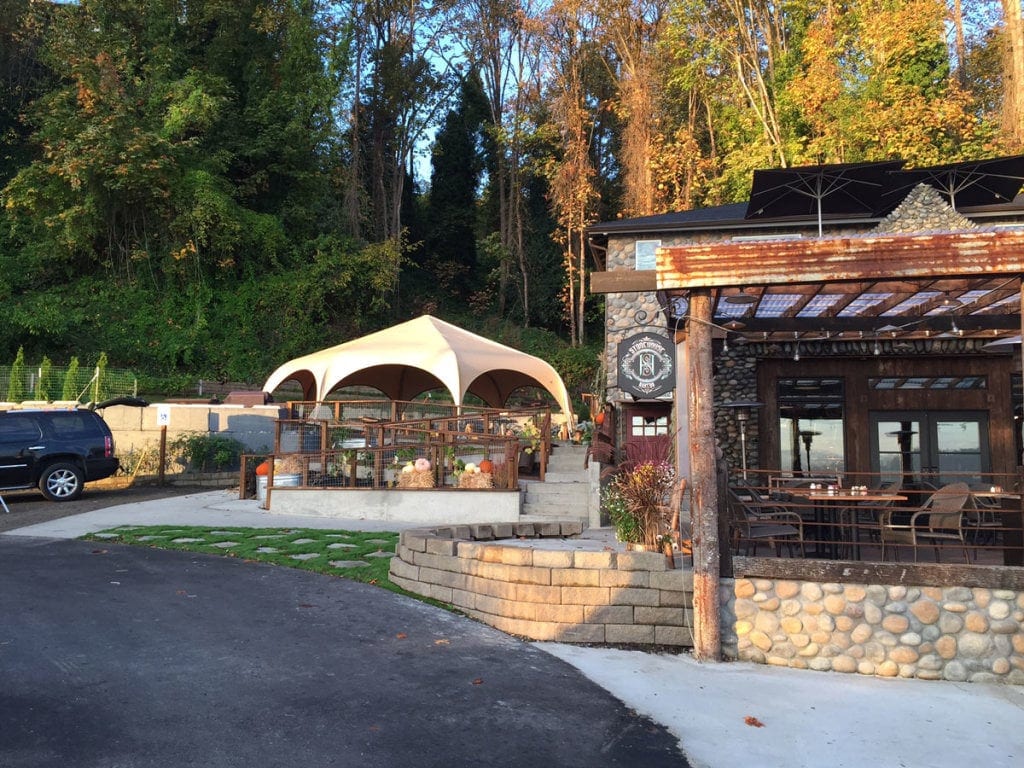
- Entry plazas and foyers
- Waiting areas
- Brewhouse
- Fermentation cellar
- Retail store
- Restrooms
- Gallery
- Beer hall
- Full-service restaurant including kitchen and food preparation area
- Event Center
- Outdoor canopies for parties and events (weddings, celebrations, business gatherings)
- Enclosures for outdoor seating, patios and beer gardens
- Mill room and loading dock area
- Packaging and shipping area
- Material and beer storage facilities (including cold storage)
- Office space
“I got to the point where the only companies I was taking seriously were ones that didn’t just make party tents. It got down to WeatherPort and one other company, but we liked that WeatherPort was made in the U.S. If we can buy American, we always do.”
-Linda Moore, Owner of Kilted Barmaid
WeatherPort’s long-lasting and durable building solutions, are custom designed to your specification, can be easily relocated, or quickly expanded as your brewery grows! Tensioned membrane structures from WeatherPort have been used by breweries, wineries, distilleries, and restaurants in more than 65 countries around the world.
Because each brewhouse is different, WeatherPort building specialists will work closely with brewery owners, brew masters, architects, and engineering firms to create a truly one-of-a-kind and unique building solution. Choose from a wide selection of window and door treatments, including large equipment doors, lighting and electrical systems, HVAC and air distribution systems, as well as proprietary insulation systems that seamlessly integrate to increase energy-efficiency as well as meet any R-value. Save money by reducing energy for lighting during the day utilizing skylight material to create a bright and welcoming interior.
WeatherPort fabric buildings are produced in the USA with the highest quality materials to create a building solution that will provide decades of use, even in the most extreme conditions. Engineering ensures their custom designed fabric structures are rated to meet local building code requirements for wind and snow loads. The tensioned fabric membrane exceeds fire safety requirements outlined by the California Code of Regulations for membrane structures, will not rot, is mold and mildew resistant, and is UV stabilized (not coated) to provide an enduring building solution for year-round use in areas with high solar loads.
Enjoy peace of mind knowing a WeatherPort fabric building is virtually maintenance free compared to conventional building methods. Save time, reduce ongoing upkeep and maintenance costs, and allow brewery owners, head brewers, and brewmasters to focus on making quality beer – all from the comfort of a custom designed fabric building!
ENCLOSURES FOR YEAR-ROUND OUTDOOR SEATING
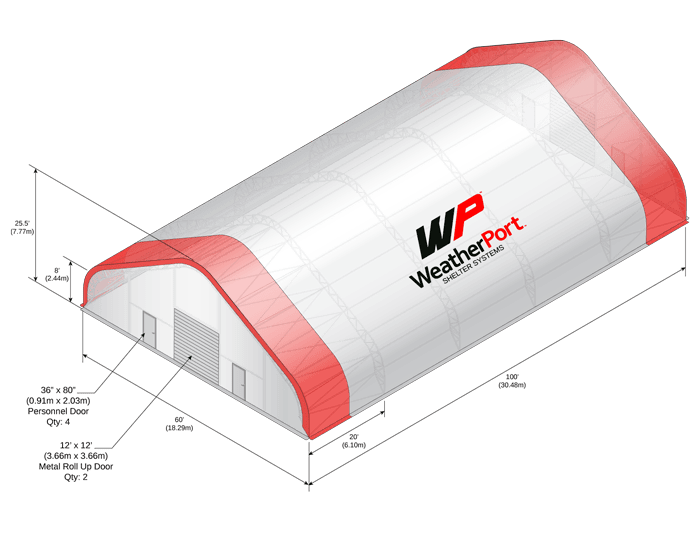
See DAGB Series
Breweries with onsite services, such as restaurants, bars, a beer hall with a taproom, and event centers need to make a lasting impression on customers. Visitors traveling from all over the U.S. (and internationally), flocking to taste your beer, are looking for an experience that will make their beercation worth talking about when they get back home. This is why brewery design, the services offered, and craftsmanship are so important to establish a place with a great ambiance and where great beer and ever lasting memories are created.
Whether expanding brewery capacity, looking to add additional services to your brewery, or build a brewery from the ground up, the design of your brewery should incorporate indoor and outdoor seating for generating additional revenue!
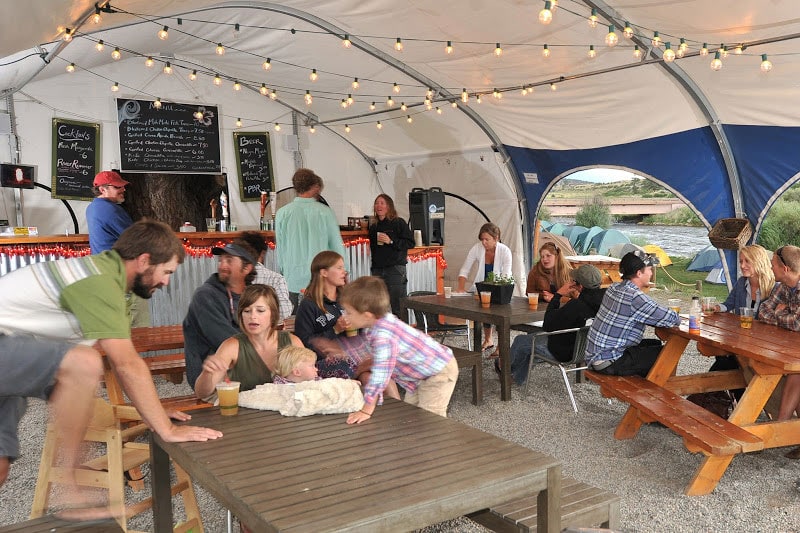
In 2013, Vucurevich Simons Advisory Group (VSAG) performed a business analysis on the financial return of a restaurant installing a patio for outdoor seating. The results were eye opening and should be considered by all breweries!
…with a proposed initial investment of $200k, the forecasted seasonal use return could result in $500k in sales. Hence, by leveraging base costs (adding labor, furnishings, real estate use taxes or public space fees and anything else associated with the front-end investment) gross profit of 65% was achieved. Overall, we also found that with a robust strategic management plan in place, there is great potential for a hearty profit return on investment.
In 2016, the Chicago Tribune reported that outdoor seating boosted sales to as much as 30 percent!
Outdoor seating and dining al fresco, or dining all’aperto in Italian (“dining outdoors”) is becoming increasingly popular. Restaurants, bars, wineries, distilleries, and breweries with outdoor seating draw more people and generate more revenue. Why settle for enjoying the revenue from seasonal outdoor seating when you can partially or fully enclose the patio with a WeatherPort fabric structure and enjoy outdoor seating year-round! WeatherPort patio enclosures can be designed for seasonal use – taken down for guests to enjoy the warm summer sun or installed as a permanent addition to your brewery. Roll-up and removable side curtains allow brewery staff to quickly adjust the covered outdoor seating environment to guests’ preference.
Here comes the math!
Let’s assume the restaurant of your brewery averages $20 per person, adding just ten tables (with 4 seats each) will net you $24,000 more per month if only filled once per day.
| 10 Days | 15 Days | 20 Days | 25 Days | 30 Days | |
| 10 Tables | $8,000 | $12,000 | $16,000 | $20,000 | $24,000 |
| 15 Tables | $12,000 | $18,000 | $24,000 | $30,000 | $36,000 |
| 20 Tables | $16,000 | $24,000 | $32,000 | $40,000 | $48,000 |
| 25 Tables | $20,000 | $30,000 | $40,000 | $50,000 | $60,000 |
| 30 Tables | $24,000 | $36,000 | $48,000 | $60,000 | $72,000 |
CONTACT US TODAY TO DISCUSS YOUR BREWERY NEEDS!
Engineered fabric structures from WeatherPort offer breweries, owners, and brew masters a sustainable brewery design for faster construction and increasing revenue. Our unique building solutions are used for enhancing, expanding, or renovating brewery facilities and operations. WeatherPort building systems have minimal foundation requirements – allowing them to be safely anchored and secured to most ground types. Engineered fabric structures from WeatherPort are green building systems for breweries looking to reduce their environmental footprint and create the needed space for turning a passion for great beer into a profitable profession!
WeatherPort® is a brand of high-quality fabric buildings from Alaska Structures®. If you are interested in learning more about our fabric buildings and remote camp systems please contact us by calling +1-907-344-1565 or completing our online form to request a consultation.


















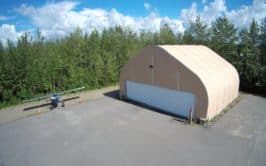























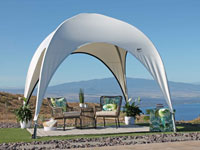





































Leave a Reply